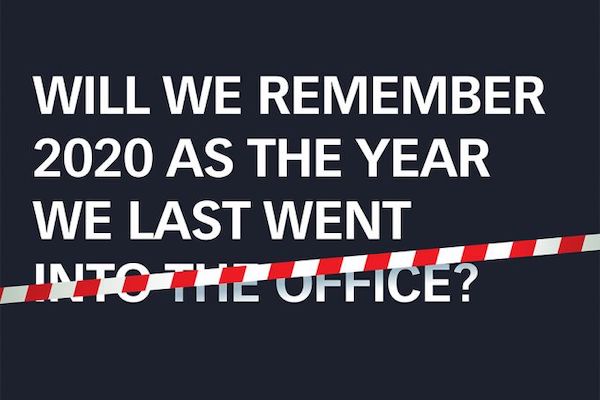Will we remember 2020 as the year we last went into the office?

Will we remember 2020 as the year we last went into the office? Will the remote workstations we have fashioned for ourselves become a permanent fixture in our homes? Much has been said about how the latest “circuit breaker” in Singapore mandating the shutdown of workplaces has propelled companies to get their digital act together, to enable employees to work from home without compromising on productivity. Lee Meixian specially for The Business Times.
Marina Krishnan, division president of corporate solutions at JLL Asia Pacific, said in a commentary in BT Weekend last week that the upending of traditional work arrangements in physical offices will likely lead to “the realisation that working from home is possible although challenging.”
While Ms Krishnan expects more companies to adopt flexible working and work-from-home policies in future, she does not expect the physical office to go away altogether. Rather, its purpose will change from a place where employees go to work, to a place for idea collaboration, stakeholder engagement and brand reinforcement.
Carol Wong, head of workplace delivery, global occupier services, Asia-Pacific, at real estate consultancy Cushman & Wakefield, on the other hand, thinks that companies will require less space due to increased agility in future, although reinvestment in technology, and the costs of supporting remote working programmes and training middle-level management to manage teams, both remotely and on-site, could negate potential cost savings in real estate.
As it is, Catherine Yeow, group business leader for HRnetOne Singapore and Thailand, notes that with the increasing trend of telecommuting in recent years, some companies are already having office space to accommodate only 70 per cent of employee strength, with the remaining 30 per cent operating from co-working spaces, individual homes or from regional offices that they frequent. Many multinational corporations here have also long implemented flexible work arrangement for staff. Ms Yeow believes that more organisations will do the same, after the Covid-19 work-from-home experience proves that it can be as productive as working out of a physical office.
Rising trend
While there are no official statistics for remote working in Singapore, data from the Ministry of Manpower’s Conditions of Employment Report released last year shows 87 per cent of employees worked in companies that offer some form of flexible work arrangements in 2018, compared to 81 per cent in 2017. A recent Covid-19 Pulse Survey conducted by Willis Towers Watson in February also showed that three-fifths of employers currently support work-from-home policies. This extends to employees across the corporate, sales and business development functions. The survey polled more than 130 organisations across 20 different industries in Singapore.
Vidisha Mehta, managing director and talent and rewards business leader, Singapore at Willis Towers Watson, notes that generally, employees are more likely to stay with organisations that offer some form of flexible work arrangements, viewing it as a sign that they are valued by the company and that the company is willing to accommodate their responsibilities outside of work.
Ms Yeow also points out that it is a draw when attracting Gen-Y and millennial talent. “More companies are also explicitly delinking productivity and results from physical attendance at the office,” she says.
What is unprecedented about the current situation however is the fact that this is probably the first time for many that entire offices have to work from home.
“This is rather challenging for some companies as physical infrastructure struggles to cope. There are still quite a number of companies where desktops are still being used and virtual private network (VPN) bandwidths are limited,” Ms Yeow says, adding: “Then you have companies where data and information are especially sensitive, such as the banking sector where the nature of business needs very tight layers of security and access has to be jealously guarded.”
Given how quickly the Covid-19 situation has aggravated, she believes that probably not all companies were ready for such a change when it kicked in two weeks ago. Some of these firms were likely caught off-guard.
Not for everyone?
The truth is that it works better for some designations, demographics, and personalities than others. Ms Yeow explains: “You will find some people with young children at home, or with home environments not set up for work, wanting to be based in the office instead. Sometimes it can be something as simple as whether the air-conditioner is switched on at home during the day. You will be surprised at the pushback as a result of increased electricity costs.”
Another reason why working from home may not be for everyone is that it demands focus and discipline. “Someone who is self-motivated, and knows exactly what he needs to do in order to excel in his role would be well-placed to work from home,” Ms Yeow cites as an example. She adds that working from home can mean more hours of solid focused work, and can result in increased productivity, but there are also some situations where working remotely can pose a challenge. “For instance, it can be more difficult to orientate and mentor a newbie remotely, and group discussions are harder to facilitate on a call.”
Willis Towers Watson’s Ms Mehta says that some people also find it hard to draw the line on stopping work, since their laptops are switched on all the time.
For sure, not all jobs can work from home. Those that require direct face-to-face interactions with people, such as waiters, healthcare workers, retail store assistants and kindergarten teachers, will find it impossible, as will on-site workers such as janitors, taxi drivers, cleaners, warehouse managers and factory workers, although an argument can be made that increasing automation is starting to replace more manual work over time, says Song Zhaoli, associate professor of management and organisation at NUS Business School.
“In essence, most types of jobs are not suitable (for working from home). Only those jobs that can be done through computer or phone are suitable,” Prof Song adds.
Jared Nai, assistant professor of organisational behaviour and human resources at the Singapore Management University (SMU) Lee Kong Chian School of Business, points out that jobs with less coordination needed between co-workers and departments lend themselves best to remote work.
Perhaps the incident of the “BBC Dad” – where a live interview with American political analyst Robert Kelly went viral after his two children barged into the room during the call – has also eased the social stigma of employees facing interruptions from children during conference calls when they work from home.
Ms Mehta says: “Although it used to be viewed as unprofessional, people tend to understand that children are stuck at home the same way we are. It’s perfectly acceptable to apologise for the interruption, or even introduce your child if you’d like, and take a minute to sort out whatever issue the child may be having.”
Social isolation
The challenge that working from home throws up is not as much about productivity as it is about meeting social needs. Human beings are social and want to feel connected with their colleagues. Developing a sense of community when working remotely is thus the biggest challenge that companies face, according to Ms Mehta.
Prof Song adds that the month-long “circuit breaker” could have the hardest impact on those who lack a social support system or are without a strong social network.
Supervisors thus need to communicate well to keep employees engaged and motivated in times of uncertainty and changes, not just via email communication but also through virtual townhalls and regular team calls, Ms Mehta notes. “It gives people a chance to catch up on their work, interesting projects or even life in general.”
It is also important to take a proactive approach to safeguard employees’ well-being and help them stay energised when they are working from home, especially for long periods.
Ms Mehta cites an example of colleagues at Willis Towers Watson recently celebrating a project win by having team drinks, where half of the team joined via video from their homes.
In the United States, work teams have also tried to build camaraderie in remote working conditions by fostering casual socialising virtually – for instance, by having “virtual lunch rooms” that anybody can enter at any time, or virtual pizza parties and remote happy hours where people dial in and have cocktails over Skype or Zoom.
Ms Yeow agrees that companies can schedule common activities together, like daily morning scrums, lunch catch-ups to review what has been achieved in the morning, and end-of-day reviews to communicate and check in with each other. For instance, at HRnetOne, working from home has not prevented colleagues from continuing to exercise together from their own homes, she says.
Not everyone believes that technology makes a good solution for social isolation, however.
SMU’s Prof Nai says: “These activities sound like replacements for in-person interactions, which may not be perfect substitutes.”
He adds that virtual communication cannot compare with face-to-face communication, as the greater psychological distance makes interactions more impersonal. People may be less willing to ask for help from others and less inclined to interact, and supervisors may also find it difficult to monitor and give instructions to employees.
There will also be less information exchange – what is sometimes called the “water cooler effect”, an idea embraced by some tech firms which deliberately create spaces for unplanned meetings and chance encounters, as they believe that team proximity can help to foster better ideas.
The utopian future of remote working?
In 2017, IT company IBM which at one point had two-fifths of its workforce working remotely, reversed its remote working policy after the company posted 20 straight quarters of losses. Management decided to get its remote workers back into the physical office, saying that its software development work requires “new ways of working” to boost collaboration and innovation. Unfortunately, this led to considerable attrition as many of these remote workers started looking for new jobs that would allow them to continue working from home.
The debate of the likelihood of a future where most companies practise remote working remains a divided one. Some, like Prof Song, think it is possible. He believes that in future, work will no longer be constrained to a physical space, but can be performed anywhere.
But Ms Mehta thinks that a more likely scenario is a middle ground, with optimal combinations of humans and machines delivering work as companies become geared towards more flexible work formats. She adds: “In any case, fully remote teams are as extreme as fully in-person operations.”
Besides physical and digital infrastructure support that is foundational to the success of remote working, there must also be work design with performance indicators to measure work on outcomes delivered, she says. “In the absence of clear outcomes, assessment of work performance is driven by the manager’s judgement, which breaks down when face time is reduced.”
Ms Mehta feels that if there is a perceived lack of trust that employees will not be productive when working remotely, that will be a major hurdle to success. Therefore, employers need to have a mindset change and build this into the company culture, especially if the organisation focuses on project-based work with flexible working processes.
“The mindset shift that will hopefully come about as a result of the current circumstances will support the move towards more flexible work arrangements,” she says. “Remote working is just one of those arrangements.”
The Business Times, 18 Apr 2020


